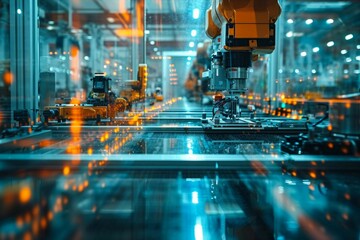Precision Robotics: Enhancing Accuracy in Automated Material Handling
Introduction
Welcome to a comprehensive exploration of precision robotics and its role in enhancing accuracy in automated material handling. In this article, we'll delve into the significance of precision robotics, its applications in material handling, and how it contributes to operational efficiency and reliability.
Outline
- Understanding Precision Robotics
- Key Components of Precision Robotics Systems
- Applications in Automated Material Handling
- Benefits of Precision Robotics
- Challenges and Considerations
- Real-World Examples
- Future Trends and Innovations
- Conclusion
- FAQS
Background
Precision robotics involves the use of advanced robotic systems equipped with high-accuracy sensors, actuators, and control algorithms to perform tasks with exceptional precision and reliability. In automated material handling, precision robotics plays a crucial role in ensuring accurate and efficient handling of goods and materials.
Understanding Precision Robotics
Precision robotics systems are designed to achieve precise positioning, manipulation, and control of objects in various industrial settings. These systems utilize advanced technologies such as computer vision, machine learning, and sensor fusion to achieve high levels of accuracy and repeatability in material handling tasks.
Key Components of Precision Robotics Systems
Key components of precision robotics systems include high-precision actuators, precision sensors, advanced control algorithms, and real-time feedback mechanisms. These components work together to enable precise motion control, object detection, grasp planning, and path optimization in material handling operations.
Applications in Automated Material Handling
Precision robotics finds applications in various automated material handling tasks such as pick-and-place operations, sorting, palletizing, assembly, and packaging. These systems are used in warehouses, distribution centers, manufacturing facilities, and logistics operations to streamline processes and improve productivity.
Benefits of Precision Robotics
The adoption of precision robotics offers several benefits, including improved accuracy, increased throughput, reduced labor costs, enhanced product quality, and greater flexibility in handling diverse materials and products. Precision robotics also enables faster cycle times and higher reliability in material handling operations.
Challenges and Considerations
Despite its advantages, precision robotics faces challenges such as high initial costs, complex integration requirements, and the need for specialized skills for programming and maintenance. Organizations must carefully evaluate these factors and consider long-term benefits when implementing precision robotics solutions.
Real-World Examples
Real-world examples of precision robotics in automated material handling include robotic arms equipped with vision systems for bin picking, robotic palletizers for efficient stacking of goods, automated guided vehicles (AGVs) for precise transportation, and robotic sortation systems for order fulfillment.
Future Trends and Innovations
The future of precision robotics in automated material handling is characterized by advancements in AI-driven robotics, collaborative robots (cobots), swarm robotics, and adaptive control strategies. Innovations such as self-learning robots, cloud-connected systems, and human-robot collaboration will continue to redefine material handling processes.
Conclusion
In conclusion, precision robotics plays a vital role in enhancing accuracy, efficiency, and reliability in automated material handling operations. By leveraging advanced technologies and intelligent algorithms, organizations can achieve higher levels of precision and productivity, ultimately driving competitiveness and success in the digital age.
FAQS
Q: How does precision robotics improve efficiency in material handling? A: Precision robotics improves efficiency by enabling accurate and reliable handling of goods, reducing cycle times, minimizing errors, and optimizing resource utilization in material handling operations.
Q: What are some challenges associated with implementing precision robotics systems? A: Challenges include high initial costs, complex integration requirements, the need for specialized skills, potential safety concerns, and the requirement for ongoing maintenance and support.
Q: What are the future trends in precision robotics for material handling? A: Future trends include advancements in AI-driven robotics, collaborative robots (cobots), swarm robotics, adaptive control strategies, and the integration of emerging technologies such as 5G connectivity, edge computing, and Internet of Things (IoT) platforms.


No comments yet